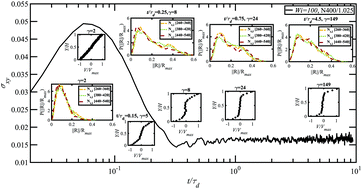Effects of chain length and polydispersity on shear banding in simple shear flow of polymeric melts
Abstract
The characteristics of shear banding were investigated in entangled, polydisperse, linear polymer melts under steady-state and startup conditions of simple shear flow. This virtual experimentation was conducted using course-grained nonequilibrium dissipative particle dynamics simulations expressed in terms of a force-field representation that faithfully models the atomistic system dynamics. We examined melts with two mean molecular bead numbers of Nn = 2 50 and 400 and polydispersity indexes of 1.0, 1.025, and 1.05. The wide range of relaxation timescales in the polydisperse melts decreased the nonmonotonic character of the steady-state shear stress vs. shear rate profile compared to a monodisperse linear melt. The polydispersity level required to observe a stress plateau in the shear stress profile at intermediate shear rates was correlated with the nominal entanglement density. Startup of shear flow simulations revealed the development of spatial inhomogeneities and dynamic instabilities in polydisperse fluids containing both monotonic and nonmonotonic shear stress flow curves. Although the shape and duration of instabilities were found to be correlated with the monotonicity of the shear stress profile, the onset and underlying mechanism leading to the formation of shear bands were generally universal. The simulations revealed that perturbations arose soon after the occurrence of a large stress overshoot under startup conditions, and that banded structures stemmed from local reorientation and subsequent deconstruction of the entanglement network. Furthermore, data indicated that the inception of strain localization occurred at shear rates near the reciprocal of the Rouse characteristic timescale, ![[small gamma, Greek, dot above]](https://www.rsc.org/images/entities/i_char_e0a2.gif) > τR−1. Transient shear banding was observed in shorter chain melts undergoing startup of shear flow in which instabilities arose after the appearance of a stress overshoot. These instabilities eventually decayed, but only long after the stresses had attained their steady-state values. The longer chain melt exhibited a shear band structure that remained indefinitely after the stresses had attained steady state.
> τR−1. Transient shear banding was observed in shorter chain melts undergoing startup of shear flow in which instabilities arose after the appearance of a stress overshoot. These instabilities eventually decayed, but only long after the stresses had attained their steady-state values. The longer chain melt exhibited a shear band structure that remained indefinitely after the stresses had attained steady state.



 Please wait while we load your content...
Please wait while we load your content...
